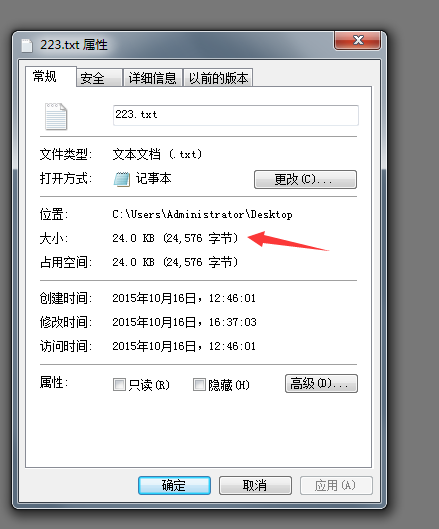以前,操作io流的时候,经常看到xxx.flush(),有的人写,有的人不写,写和不写又没什么差别,那么这个flush()有什么用呢?程序中需要调用吗?
自己对这个做了个学习,写下来方便大家。。。。可能有写的不对,请大家批评指正
先来看个简单的demo
public class IOTest {
public static final int READ_LENGTH = 1024;
public static void main(String args[]) {
BufferedInputStream bufferedInputStream = null;
BufferedOutputStream bufferedOutputStream = null;
try {
File file = new File("C:\\Users\\Administrator\\Desktop\\123.txt");//读取的文件
File file1 = new File("C:\\Users\\Administrator\\Desktop\\223.txt");//写入的文件
bufferedInputStream = new BufferedInputStream(new FileInputStream(file));
bufferedOutputStream = new BufferedOutputStream(new FileOutputStream(file1));
byte[] b = new byte[READ_LENGTH];
int temp = 0;
while ((temp = bufferedInputStream.read(b, 0, READ_LENGTH)) > 0) {
bufferedOutputStream.write(b, 0, temp);
}
// bufferedOutputStream.flush();
//这里注释掉和不注释 ,结果都是一样的,原文件和拷贝的文件都是27.3 KB (28,012 字节),文中数据也一致
} catch (IOException e) {
} finally {
try {
if (bufferedInputStream != null) {
bufferedInputStream.close();
}
if (bufferedOutputStream != null) {
bufferedOutputStream.close();
}
} catch (IOException e1) {
}
}
}
}然后我们把下面的代码注释
// try {
// if (bufferedInputStream != null) {
// bufferedInputStream.close();
// }
//
// if (bufferedOutputStream != null) {
// bufferedOutputStream.close();
// }
// } catch (IOException e1) {
//
// }然后在运行程序,分别看下文件的大小
原文件的大小27.3 KB (28,012 字节),复制后223.txt 变成了24.0 KB (24,576 字节)
为什么成了24,576, 其实仔细算一下,就会发现 24576 正好是1024(代码中READ_LENGTH)倍数,把READ_LENGTH换成别的数值,也是一样的道理
问题回来,为什么注释掉close()方法,就发生了这么大的改变,来看看close()中到底做了什么?
/**
* Closes this output stream and releases any system resources
* associated with the stream.
* <p>
* The <code>close</code> method of <code>FilterOutputStream</code>
* calls its <code>flush</code> method, and then calls the
* <code>close</code> method of its underlying output stream.
*
* @exception IOException if an I/O error occurs.
* @see java.io.FilterOutputStream#flush()
* @see java.io.FilterOutputStream#out
*/
@SuppressWarnings("try")
public void close() throws IOException {
try (OutputStream ostream = out) {
flush();
}
}
/**
* Flushes this buffered output stream. This forces any buffered
* output bytes to be written out to the underlying output stream.
*
* @exception IOException if an I/O error occurs.
* @see java.io.FilterOutputStream#out
*/
public synchronized void flush() throws IOException {
flushBuffer();
out.flush();
}
/** Flush the internal buffer */
private void flushBuffer() throws IOException {
if (count > 0) {
out.write(buf, 0, count);
count = 0;
}
}
恍然大悟,即使你不用flush(),在close 方法中也会调用flush(); flush方法其实也就是将缓存区的数据用write方法写了出去
那么在程序中,你需要自己显示的调用flush() 吗?
我个人觉得还是有必要的,除非你能很确定stream成功的调用close()了!























 1650
1650











 被折叠的 条评论
为什么被折叠?
被折叠的 条评论
为什么被折叠?








